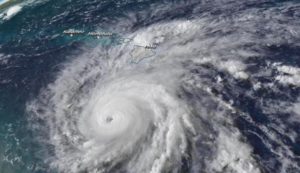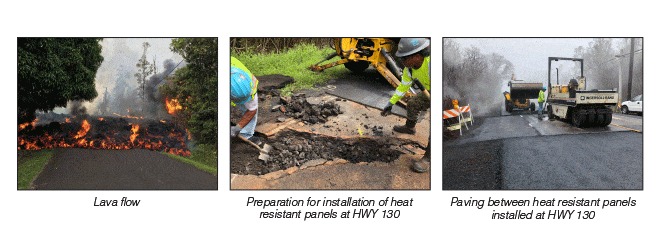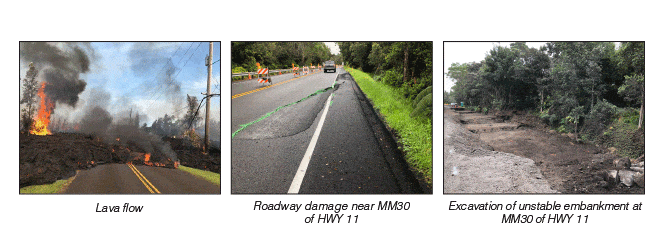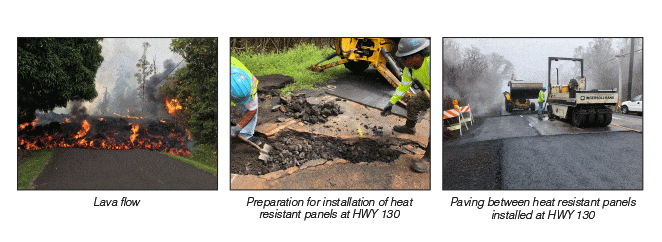The entire SSFM team was on call 24/7 throughout the crisis. Robyn Ito recalls “For us, the phone didn’t stop ringing just because it was a Saturday or Sunday, 6 o’clock in the morning, or 9 o’clock at night.”
Two Unprecedented Disasters at Once
First the Volcano…

SSFM’s commitment to service has never been more evident than in responding to the concurrent natural disasters that struck the Big Island of Hawaii last year. Beginning with the sudden eruption of the Kilauea Volcano, and a 6.9 magnitude earthquake, the volcanic activity lasted nearly 4 months and quickly became the most destructive in Hawaii’s recorded history. Communities in the southeast corner of the Island were slowly engulfed by the lava flow. Tremors and geological instability damaged numerous structures and made essential highways impassible.
…and Then the Hurricane

Hurricane Lane approached at the height of the intense response to the volcano. While State and County officials were continuing to cope with the dramatic impacts of the still-active volcano, the island was slammed with massive amounts of rain from the outer bands of the hurricane. The epic storm dropped more than 52 inches in a four-day period – the most rainfall from a cyclonic event in the Island’s history and the second most anywhere in the US since 1950. Homes, schools, and businesses were flooded. Vital highways were made impassible by massive mudslides and flooding.
The destruction wrought by either of these natural disasters alone would have had a devastating impact on the Island’s infrastructure. Their combined impact was nearly overwhelming. Together, the volcano and hurricane ruptured the only transportation linkages between the east and west sides of the island and had direct impact on the many communities that lie in between.
Turning to SSFM for Help
Remediating the damage to the State roads fell to the State Department of Transportation (DOT) District Office in Hilo. In the immediate aftermath of the eruption, DOT needed to act quickly but lacked the internal resources to address such massive challenges. SSFM was a logical place to turn to for the necessary supplemental resources and expertise, due to the firm’s multidiscipline capabilities, familiarity with the State procedures and Federal requirements and their readiness to respond.

The first call to SSFM came just a few days after the first fissures began spewing lava. Each day brought multiple seismic events as more fissures opened in Leilani Estates and lava flows threatened the homes of hundreds of residents. State highways critical to the Island’s transportation infrastructure and economy were becoming increasingly impassible from Pahoa to Volcano due to cracks or sinkholes forming along the roads.
Commitment
Austen Drake, SSFM’s General Manager for Hawaii Island said there was never any doubt about what the company would do. “This is where we live. It’s our community and it’s the roads we drive on every day. The only thing to do was mobilize our team and help any way we could.” The company’s efforts were led by Senior Project Engineer Robyn Ito and Construction Manager Renee Ishisaka. Ultimately, they were supported by a ten person team, including permit specialist Jennifer Scheffel.
Facing the Challenge
There was no roadmap to follow in responding. “When you’re an engineer on the Island of Hawaii, you’re aware of lots of design solutions related to eruptions, but not 5.5 magnitude earthquakes rattling the earth on a daily basis,” Drake said.
The entire SSFM team was on call 24/7 throughout the crisis. Ito recalls “For us, the phone didn’t stop ringing just because it was a Saturday or Sunday, 6 o’clock in the morning, or 9 o’clock at night.” The team collaborated with state officials at all hours of the day and night to inspect new damage and identify quick fix solutions or alternative routes in order to keep the highway system functioning. Each day, the entire roadway system in the vicinity of the volcano was inspected for new cracks and sinkholes with triage the order of the day, every day.
The highest priority was maintaining a safe route for emergency vehicles. Due to the extreme topography of the Big Island, there are not many road options. An impassable route is the difference between 20 minutes or 3 hours to the nearest emergency facility. SSFM’s construction management team, led by Ishisaka, remained on call around the clock to ensure provisions were in place to keep traffic moving while road repairs were being performed. Working with contractors, establishing traffic control, and ensuring no invasive species enter the sensitive National Park areas were just a small part of what Ishisaka’s team did each day. Her team also managed the installation of some rather innovative slope stability solutions, such as welded wire frames, not commonly used on the Big Island.

In addition to the physical repairs, environmental processing was necessary with numerous County, State and Federal agencies. The State and County relied on SSFM’s Strategic Services Group to assist with obtaining environmental clearances to allow work to continue without unimpeded.
After the hurricane, it became critical for DOT to fortify bridge abutments and piers that were undermined by the flood waters. There were also multiple landslides along the Hamakua Coast, an area whose community’s only link to emergency services and other essentials is Mamalahoa Highway. With all of these simultaneous recovery efforts, DOT again turned to SSFM for assistance with the environmental clearances and with managing the multiple on-going emergency repairs needed to keep the critical roads open. Much of this repair work was led by SSFM Construction Inspector, Chris Harris.
The Hurricane’s effects were felt island-wide. In addition to the Department of Transportation’s needs, the Department of Education also enlisted SSFM in addressing significant damage incurred by schools including classrooms, cafeterias, kitchens, and band rooms. Over the weekend of the hurricane, SSFM mobilized a team, which included engineers from Oahu, to assess flooding impacts at schools in the Hilo and Keaau communities.

The Road Ahead
Even though Kilauea has quieted and Hurricane Lane is long gone, SSFM continues to work closely with County, State and Federal personnel to ensure the affected communities can maintain their way of life. SSFM, and especially professionals in its Hilo Office, is gratified to have played an important role in assisting in the Island’s return to normalcy.
About the Team
Austen Drake, P.E., LEED AP BD+C is the General Manager of SSFM’s Big Island office. He leads the team tackling the Island’s disaster relief program. Austen joined SSFM in 2008. He holds a B.S. in civil engineering from the University of Texas at Arlington.
Robyn Ito, PMP, P.E. is a civil engineer and senior associate with SSFM. Robyn has been with the firm since 2004 and is currently a Senior Project Engineer in SSFM’s Hilo Engineering Group. Robyn holds a degree in Aerospace Engineering from the University of Southern California.
Renee Ishisaka, P.E., S.E., LEED AP is a structural and civil engineer in SSFM’s Hilo office. Renee has been with the firm for over a decade. She holds B.S and M.S degrees in civil engineering from the University of Hawaii at Manoa.
Two Unprecedented Disasters at Once
First the Volcano…

SSFM’s commitment to service has never been more evident than in responding to the concurrent natural disasters that struck the Big Island of Hawaii last year. Beginning with the sudden eruption of the Kilauea Volcano, and a 6.9 magnitude earthquake, the volcanic activity lasted nearly 4 months and quickly became the most destructive in Hawaii’s recorded history. Communities in the southeast corner of the Island were slowly engulfed by the lava flow. Tremors and geological instability damaged numerous structures and made essential highways impassible.
SSFM’s commitment to service has never been more evident than in responding to the concurrent natural disasters that struck the Big Island of Hawaii last year. Beginning with the sudden eruption of the Kilauea Volcano, and a 6.9 magnitude earthquake, the volcanic activity lasted nearly 4 months and quickly became the most destructive in Hawaii’s recorded history. Communities in the southeast corner of the Island were slowly engulfed by the lava flow. Tremors and geological instability damaged numerous structures and made essential highways impassible.
…and Then the Hurricane
More / Less

Hurricane Lane approached at the height of the intense response to the volcano. While State and County officials were continuing to cope with the dramatic impacts of the still-active volcano, the island was slammed with massive amounts of rain from the outer bands of the hurricane. The epic storm dropped more than 52 inches in a four-day period – the most rainfall from a cyclonic event in the Island’s history and the second most anywhere in the US since 1950. Homes, schools, and businesses were flooded. Vital highways were made impassible by massive mudslides and flooding.
The destruction wrought by either of these natural disasters alone would have had a devastating impact on the Island’s infrastructure. Their combined impact was nearly overwhelming. Together, the volcano and hurricane ruptured the only transportation linkages between the east and west sides of the island and had direct impact on the many communities that lie in between.
Turning to SSFM for Help
Remediating the damage to the State roads fell to the State Department of Transportation (DOT) District Office in Hilo. In the immediate aftermath of the eruption, DOT needed to act quickly but lacked the internal resources to address such massive challenges. SSFM was a logical place to turn to for the necessary supplemental resources and expertise, due to the firm’s multidiscipline capabilities, familiarity with the State procedures and Federal requirements and their readiness to respond.

The first call to SSFM came just a few days after the first fissures began spewing lava. Each day brought multiple seismic events as more fissures opened in Leilani Estates and lava flows threatened the homes of hundreds of residents. State highways critical to the Island’s transportation infrastructure and economy were becoming increasingly impassible from Pahoa to Volcano due to cracks or sinkholes forming along the roads.
Commitment
Austen Drake, SSFM’s General Manager for Hawaii Island said there was never any doubt about what the company would do. “This is where we live. It’s our community and it’s the roads we drive on every day. The only thing to do was mobilize our team and help any way we could.” The company’s efforts were led by Senior Project Engineer Robyn Ito and Construction Manager Renee Ishisaka. Ultimately, they were supported by a ten person team, including permit specialist Jennifer Scheffel.
Facing the Challenge
There was no roadmap to follow in responding. “When you’re an engineer on the Island of Hawaii, you’re aware of lots of design solutions related to eruptions, but not 5.5 magnitude earthquakes rattling the earth on a daily basis,” Drake said.
The entire SSFM team was on call 24/7 throughout the crisis. Ito recalls “For us, the phone didn’t stop ringing just because it was a Saturday or Sunday, 6 o’clock in the morning, or 9 o’clock at night.” The team collaborated with state officials at all hours of the day and night to inspect new damage and identify quick fix solutions or alternative routes in order to keep the highway system functioning. Each day, the entire roadway system in the vicinity of the volcano was inspected for new cracks and sinkholes with triage the order of the day, every day.
The highest priority was maintaining a safe route for emergency vehicles. Due to the extreme topography of the Big Island, there are not many road options. An impassable route is the difference between 20 minutes or 3 hours to the nearest emergency facility. SSFM’s construction management team, led by Ishisaka, remained on call around the clock to ensure provisions were in place to keep traffic moving while road repairs were being performed. Working with contractors, establishing traffic control, and ensuring no invasive species enter the sensitive National Park areas were just a small part of what Ishisaka’s team did each day. Her team also managed the installation of some rather innovative slope stability solutions, such as welded wire frames, not commonly used on the Big Island.

In addition to the physical repairs, environmental processing was necessary with numerous County, State and Federal agencies. The State and County relied on SSFM’s Strategic Services Group to assist with obtaining environmental clearances to allow work to continue without unimpeded.
After the hurricane, it became critical for DOT to fortify bridge abutments and piers that were undermined by the flood waters. There were also multiple landslides along the Hamakua Coast, an area whose community’s only link to emergency services and other essentials is Mamalahoa Highway. With all of these simultaneous recovery efforts, DOT again turned to SSFM for assistance with the environmental clearances and with managing the multiple on-going emergency repairs needed to keep the critical roads open. Much of this repair work was led by SSFM Construction Inspector, Chris Harris.
The Hurricane’s effects were felt island-wide. In addition to the Department of Transportation’s needs, the Department of Education also enlisted SSFM in addressing significant damage incurred by schools including classrooms, cafeterias, kitchens, and band rooms. Over the weekend of the hurricane, SSFM mobilized a team, which included engineers from Oahu, to assess flooding impacts at schools in the Hilo and Keaau communities.
The Road Ahead
Even though Kilauea has quieted and Hurricane Lane is long gone, SSFM continues to work closely with County, State and Federal personnel to ensure the affected communities can maintain their way of life. SSFM, and especially professionals in its Hilo Office, is gratified to have played an important role in assisting in the Island’s return to normalcy.

About the Team
Austen Drake, P.E., LEED AP BD+C is the General Manager of SSFM’s Big Island office. He leads the team tackling the Island’s disaster relief program. Austen joined SSFM in 2008. He holds a B.S. in civil engineering from the University of Texas at Arlington.
Robyn Ito, PMP, P.E. is a civil engineer and senior associate with SSFM. Robyn has been with the firm since 2004 and is currently a Senior Project Engineer in SSFM’s Hilo Engineering Group. Robyn holds a degree in Aerospace Engineering from the University of Southern California.
Renee Ishisaka, P.E., S.E., LEED AP is a structural and civil engineer in SSFM’s Hilo office. Renee has been with the firm for over a decade. She holds B.S and M.S degrees in civil engineering from the University of Hawaii at Manoa.
Category:
Climate Change
